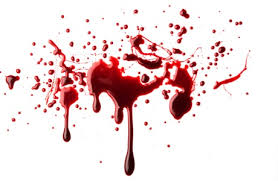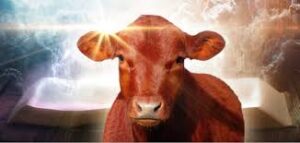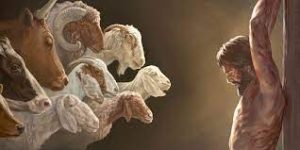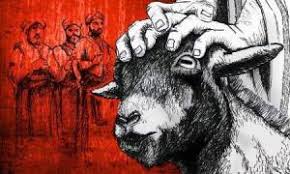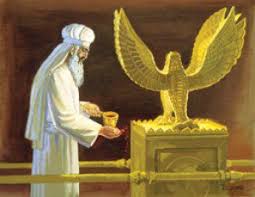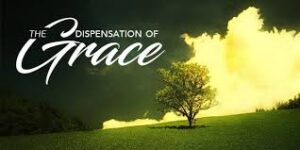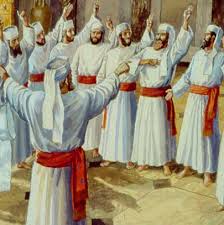Bz – The Better Tabernacle Purified with Better Blood 9: 23-28
The Better Tabernacle Purified with Better Blood
9: 23-28
The better Tabernacle purified with better blood DIG: Because God was so satisfied with Yeshua’s sacrifice, what did He do for Him (see Philippians 2:9)? Why was the tax collector justified rather than the Pharisee in the story in Luke 18? For whom did Christ appear in the presence of God? What are two proofs that are found in verses 24 and 25 that show that Messiah’s sacrifice was a better one? If Jesus’ sacrifice had not been sufficient, what would have to happen? The perpetual offering of Christ by the Roman Catholic Church contradicts what biblical truth?
REFLECT: The author used analogies from the TaNaKh to explain the meaning of Messiah’s death to the Israelites. What analogies might you use to explain it to people you know? Does the fact that Yeshua died to take away your sins free you to serve Him more? Or make you spiritually “lazy?” Why?
There are three results of the Messiah’s sacrifice. The third result of His sacrifice is His ministry in the heavenly Tabernacle. In the preceding file, the author focused on the use of blood for the purifying and remission of sin. Now, the use of blood in preparation for the way of approach is going to be enlarged. The author shows that Yeshua purified the heavenly Tabernacle through His own blood unlike Moshe who purified the earthly Tabernacle with the blood of bulls and goats. Therefore, Yeshua dwelt in a better Tabernacle, and purified it with better blood . . . His own blood.
Because, as seen previously, without the shedding of blood there can be no forgiveness of sins (9:22 CJB), this is how the copies of the heavenly things had to be purified, but the heavenly things themselves require better sacrifices than these (9:23 CJB). The purifying of the heavenly Tabernacle pictures the purifying of the earthly Tabernacle. The copies of the heavenly things are the earthly Tabernacle, its seven pieces of fixtures and all its furnishings. The use of animal blood had to be used to purify the earthly Tabernacle because they were only copies and animal blood was sufficient to purify them. However, the heavenly Tabernacle is the original, and it was necessary to purify it with better blood, the blood of Jesus. Although the sacrifice that Yeshua made was a one-time sacrifice, the term sacrifices (Greek: thusiais) is plural. It is a generic or intensive plural that shows all the sacrifices made during the Dispensation of the Torah were fulfilled in the one sacrifice of Messiah. His sacrifice had to be better because the heavenly Tabernacle required better purifying in keeping with its better nature.241
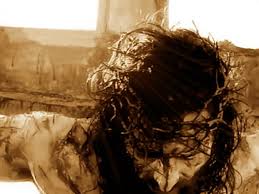
This raises the obvious question: Why did the heavenly Tabernacle need to be purified? First, when the Adversary rebelled against God, he did so while he was still in heaven and, thus, Satan’s rebellion brought sin into heaven itself (Isaiah 14:12-14; Ezeki’el 28:11-19). The Ezeki’el passage states that he desecrated the sanctuary in heaven. As a result, heaven was not pure (Job 15:15, 25:5). Second, mankind is untied with creation. When Adam sinned, his sin reached up to heaven. When Jesus died, He reconciled things in heaven as well as on earth: He reconciled all things to Himself, whether on earth or things in heaven, by making peace through His blood, shed on the cross (Colossians 1:20)
In verses 24-26 the Ruach HaKodesh deals with Messiah’s once-for-all entrance into God’s presence for us, and points out three key truths. First, Christ entered into heavenly Tabernacle. Messiah entered into the heavenly Tabernacle and not into the Most Holy Place on earth. For the Messiah has entered the Most Holy Place that is not made with human hands and merely a copy of the true one, but into heaven itself, in order to appear now on our behalf in the very presence of God (9:24 CJB). On Yom Kippur, the Day of Atonement (see the commentary on Exodus, click to see link Go – The Day of Atonement), the high priest entered the Most Holy Place alone, and, in essence his work there was a secret ministry. What’s more, before he did so, the smoke from the Altar of Incense preceded him into the Most Holy Place so that his face was hidden. That smoke protected him from looking at the Shechinah glory, the visual manifestation of God’s presence. So while the high priest entered into the earthly Most Holy Place in secret and hidden by smoke, Jesus Christ entered boldly into the heavenly Most Holy Place. He did not enter the Most Holy Place made with human hands, but made by YHVH alone. When Jesus entered in, He went in for us. Isn’t it beautiful to realize that when He went in, we went in with Him? Because we’re in Christ (Ephesians 1:3), we were ushered into the presence of God with Him.242
The second truth is that Yeshua entered with a finished atonement. Again a contrast is made between the once-for-all-time offering of Messiah compared with the yearly offering of the high priest. Further, He did not enter the heavenly Tabernacle to offer Himself over and over again, like the high priest who enters the Most Holy Place year after year with blood that is not his own. Otherwise Yeshua would have to suffer death many times – from the founding of the universe on (9:25-26:a CJB). If Jesus’ sacrifice had not been once-for-all-time, He would have had to suffer from the founding of the universe. He would have to die continuously, as it were, since the time Adam sinned. Like the work of the Levitical priesthood, His atoning work would have never be finished. But praise God, His sacrifice doesn’t have to be repeated – not even once. It is completely finished.
The Roman Catholic idea of the perpetual sacrifice of Messiah is a heretical doctrine that for many centuries has contradicted this, and many other clear biblical teachings about the finished work of Christ. It maintains that, inasmuch as the priesthood of Jesus is perpetual and sacrifice is an essential part of His priesthood, therefore the sacrificial offering of Christ must also be perpetual.
Ludwig Ott, a Roman Catholic theologian, explains this perpetual sacrifice dogma, which was made official by that church at the Council of Trent in the middle of the sixteenth century. “The holy mass,” he writes, “is a true a proper sacrifice. It is physical and propitiatory (meaning the averting of God’s wrath by means of the substitutionary sacrifice of Jesus that satisfies every claim of God’s holiness and justice so that He is free to act on behalf of sinners), removing sins and conferring the grace of repentance. Propitiated by the offering of this sacrifice, God, by granting the grace of the gift and the gift of Penance, remits trespasses and sin however grievous they may be.”243
Roman Catholics who take their church membership seriously and who, in most cases, have had it drilled into them from infancy that in the mass a daily sacrifice is offered to them, find it extremely hard to leave the Roman Church precisely because in the Messianic community, or in the evangelical church, they find no mass. And they fear that without the mass they will lose their salvation. A devout Roman Catholic regards this matter of salvation through the mass far more seriously than most messianic Jews or believing evangelicals realize. But when one begins to read the Bible thoughtfully and prayerfully, he discovers that Christ made the only sacrifice necessary for salvation on the cross of Calvary, and the mass cannot possibly be a continuing sacrifice.244
No doubt some Catholics are saved, but in holding to the doctrine of the perpetual offering of His sacrifice, they undermine the power and significance of Messiah’s once-for-all-time sacrifice. This false doctrine is plainly reflected in the crucifix, the ubiquitous symbol of Roman Catholicism. Whether in pictures, in statues, the cross is rarely empty in Catholic representations. To Catholics, Yeshua is still being crucified. In communion, or the Lord’s Supper we remember Christ’s sacrificial death, as He commanded us to do. But He is not re-sacrificed. Our Lord commanded His disciples to remember His death (see the commentary on The Life of Christ Kj – Breaking the Middle Matzah).245
The third key truth is that having entered into heaven with a finished atonement, Jesus conquered sin forever. But as it is, Messiah had appeared once at the end of the ages in order to set aside sin through the sacrifice of Himself (9:26b CJB). Having entered into heaven with a completely finished atonement, Jesus did away with sin forever in the sense that the believer is justified at the moment of faith (see the commentary on The Life of Christ Bw – What God Does For Us at the Moment of Faith). The timing was at the end of the ages. This expression means it was at the end of the Dispensation of the Torah (see the commentary on Exodus Da – The Dispensation of the Torah), similar to what Rabbi Sha’ul states: But when the appointed time arrived, God sent forth His Son. He was born from a woman, born into a culture in which legalistic perversion of the Torah was the norm (Galatians 4:4 CJB).
When ADONAI’s timetable reached the proper moment, Christ was born (see the commentary on The Life of Christ Aq – The Birth of Jesus). The key purpose was to do away with sin. He would not merely achieve forgiveness, or temporary covering of sin, which the righteous of the TaNaKh achieved, but now the sins of the righteous would be set aside (Greek: athetesin, meaning it was no longer in effect). Just as the Levitical priesthood was set aside (7:18), so Yeshua also came to set aside sin. Unlike the temporary work of the Levitical priests, Messiah did one perfect work and set aside sin forever through the sacrifice of Himself. Not by blood that was not His own, but by His own blood.
There were Jewish unbelievers in the Messianic congregation to which the author was writing. He had warned them that they were in danger (see Ag – The Audience of the book of Hebrews). But, here again, writer warns them that just as people are destined to die just once. Everyone has to die, and our death is by divine appointment. This is the Bible’s refutation of the concept of reincarnation, which is found in most Eastern religions and incorporated into a number of recent Western imitations. And after that to face the judgment (9:27 CJB), which is also appointed by God. Since we are not able to atone for our own sins, Ha’Shem’s judgment demands that we pay for them ourselves, or have a substitute pay for them.
Like everyone else, Yeshua Messiah was divinely destined to die just once. But unlike us, He will never face judgment. Because He took out sins upon Himself, He took our judgment upon Himself. But the judgment was for our sins, not His, for He had none. He was our substitute. God made Him who had no sin to be sin for us, so that in Him we might become the righteousness of God (Second Corinthians 5:21). He dies the one death that judgment demanded.
On the Day of Atonement, the people waited eagerly to see the high priest come out from the Most Holy Place. If he did anything wrong, if he failed to follow Ha’Shem’s precise instructions, he would die. So there was always a sight of relief, for their own sakes as well as his, when he reappeared.
That was the situation being alluded to here in 9:28. If the people were so eager to see the former high priests reappear from the earthly Most Holy Place, how much more should believers look eagerly for their great High Priest, Yeshua Messiah, to reappear from the heavenly Most Holy Place? This will occur at the Second Coming (see the commentary on Isaiah Kg – The Second Coming of Jesus Christ to Bozrah).246
So Messiah was sacrificed once to bare the sins of many (Hebrews 9:28a quoting Isaiah 53:12); and he will appear a second time, not to bear sin, but to deliver those who eagerly await Him (9:28b CJB). Here is the clearest statement in the Bible of the relationship between Yeshua’s First and Second Comings. His First Coming fulfilled the prophecy of Isaiah 52:13-53:12 (see the commentary on Isaiah Iy – The Death of the Suffering Servant), which predicted that Messiah would die as an atonement for human sin and be raised from the dead, so that He could appear a second time to fulfill such prophecies as Isaiah 2:2-5 and 9:6-7, which say that Messiah will bring peace to the world and deliver His people once the leadership of Isra’el asks Him to come back (see the commentary on Revelation Ev – The Basis for the Second Coming of Jesus Christ).247
You can’t forgive me for my sins nor can I forgive you for yours. Two kids in a mud puddle can’t clean each other. They need someone clean. Someone spotless. We need someone clean us too. That’s why we need a Savior. Trying to make it to heaven on our own goodness is like trying to get to the moon on a moon beam . . . nice idea, but try it and see what happens. Listen. Quit trying to quench your own guilt. You can’t do it. There’s no way. Not with a bottle of whiskey or perfect attendance at Hebrew School or Sunday School. Sorry. I don’t care how bad you are. You can’t be bad enough to forget it. And I don’t care how good you are. You can’t be good enough to overcome it. You need a Savior. A Substitute. We all do!248



